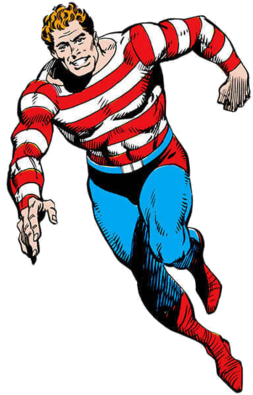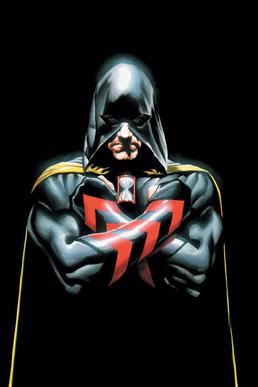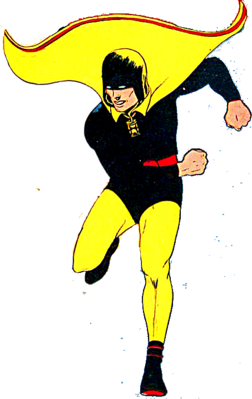Related Research Articles

The Justice Society of America (JSA), is a superhero team appearing in American comic books published by DC Comics. It was conceived by editor Sheldon Mayer and writer Gardner Fox during the Golden Age of Comic Books. It first appeared in All Star Comics #3, making it the first team of superheroes in comic books. Its original members were Doctor Fate, Hourman, the Spectre, Sandman, Atom, the Flash, Green Lantern and Hawkman.

The Sandman is a superhero appearing in American comic books published by DC Comics. The first of several DC characters to bear the name Sandman, he was created by writer Gardner Fox and artist Bert Christman. Attired in a green business suit, fedora, and World War I gas mask, the Sandman used a gun emitting a sleeping gas to sedate criminals. He was originally one of the "mystery men" to appear in comic books and other types of adventure fiction in the 1930s, but later was outfitted with a unitard/cowl costume and developed into a proper superhero, acquiring a sidekick, Sandy, and founding the Justice Society of America (JSA).

Doctor Fate, also known as Fate or collectively as Fate's Legacy, is the name of several superheroes appearing in American comic books published by DC Comics. The first version was originally created by writer Gardner Fox and artist Howard Sherman, debuting in More Fun Comics #55. Throughout the character's extensive history, various incarnations of Doctor Fate emerged as deliberate attempts to reinvigorate the character.

Infinity, Inc. is a team of superheroes appearing in American comic books published by DC Comics.
The Injustice Society is a group of supervillains in the DC Comics Universe. They are the main antagonists of the Justice Society of America.

S.T.R.I.P.E. is a superhero in the DC Comics Universe. S.T.R.I.P.E. is a powered armor suit invented and worn by Patrick "Pat" Dugan, the former adult sidekick to teenage superhero Sylvester Pemberton, the Star-Spangled Kid. "Stripesy", as he was originally called, is a gifted mechanic who built the Star Rocket Racer, a bubble-topped limousine with the functions of a rocket and helicopter. Together, they were members of the Seven Soldiers of Victory and the All-Star Squadron. Stripesy was created by Jerry Siegel and Hal Sherman, and first appeared in Star Spangled Comics #1.

Sanderson "Sandy" Hawkins, formerly known as Sandy the Golden Boy, Sands, Sand and currently known as Sandman, is a character appearing in comics published by DC Comics. He was created by writer Mort Weisinger and artist Paul Norris, he first appeared in Adventure Comics #69. After being unutilized for several years, he was reintroduced by writers David S. Goyer and Geoff Johns in the comic JSA in the late 1990s and with a greatly expanded set of powers and responsibilities. He eventually took on the name of Sandman, succeeding his former mentor.

All Star Comics is an American comic book series from All-American Publications, one of three companies that merged with National Periodical Publications to form the modern-day DC Comics. While the series' cover-logo trademark reads All Star Comics, its copyrighted title as indicated by postal indicia is All-Star Comics, with a hyphen. With the exception of the first two issues, All Star Comics told stories about the adventures of the Justice Society of America, the very first team of superheroes. It also introduced Wonder Woman.

Courtney Elizabeth Whitmore, known as Stargirl, is a superhero created by Geoff Johns and Lee Moder who appears in American comic books published by DC Comics. The character's name, appearance, and personality were patterned after Johns' 18-year-old sister Courtney, who died in the explosion of TWA Flight 800 in 1996.

The Seven Soldiers of Victory is a team of fictional comic book superheroes in the DC Comics universe. They first appeared in Leading Comics #1, and were created by Mort Weisinger and Mort Meskin. The team was a short-lived assembly of some of the less famous superheroes in the DC Universe who have made occasional appearances since their Golden Age debut.

Icicle is the name of two supervillains appearing in comic books published by DC Comics: Joar Mahkent and Cameron Mahkent.

Hourman is a fictional superhero who was created by Roy Thomas, Dann Thomas and first appeared in Infinity Inc. #20 as Rick Tyler, son of the original Hourman, who quickly joined Infinity Inc. as the second Hourman in #21 of that book.

"The Justice Society Returns" is a nine issue story arc that ran through a number of comic books published by DC Comics in 1999, reviving the Golden Age superhero team, which had previously been revived in the 1980s.

Al Pratt is a fictional character appearing in American comic books published by DC Comics. He is the first character to use the name Atom. He initially had no superpowers and was originally a diminutive college student and later a physicist, usually depicted as a "tough-guy" character. Al Pratt is also the father of Damage and godfather of Atom Smasher.

Hourman is a fictional superhero appearing in comics published by DC Comics. He is known as the original Hourman. He was created by writer Ken Fitch and artist Bernard Baily in Adventure Comics #48, during the Golden Age of Comic Books. He continued to appear in Adventure Comics until issue #83.

Theodore "Ted" Grant is a fictional character, a DC Comics superhero, known as the original Wildcat and a long-time member of the Justice Society of America (JSA). A world-class heavyweight boxer, Grant became inadvertently entangled in the criminal underworld and developed a costumed identity to clear his name.

Hector Hall is a superhero appearing in American comic books published by DC Comics. Created by Roy Thomas and Jerry Ordway, he made his first appearance in All-Star Squadron #25. Throughout the character's history, he has adopted several superhero codenames.In the DC Universe, the character is frequently associated with the legacy of the Golden Age heroes Hawkman and Hawkwoman/Hawkgirl, either as their biological or spiritual offspring. This connection stems from the character's inherited abilities related to reincarnation.

DC Universe: Legacies is a 2010–2011 ten-issue comic book limited series written by Len Wein and published by DC Comics. It details the perspective of an admirer of superheroes in the DC Universe from the Golden, Silver, Bronze, and Modern eras of comic books.
Brain Wave is a supervillain appearing in the DC Comics Universe, a recurring foe of the Justice Society of America and a founding member of the Injustice Society; he is also the father of the superhero Brainwave.
"The New Golden Age" is a crossover event in DC Comics publications. Written by Geoff Johns, the story follows the Justice Society of America unraveling a mystery following the Golden Age heroes and villains. The story comprises an eponymous one-shot and the central storyline in the ongoing Justice Society of America, as well as tie-in limited series like Stargirl: The Lost Children, Alan Scott: The Green Lantern, Jay Garrick: The Flash, and Wesley Dodds: The Sandman. The event received highly positive reviews from critics.
References
- ↑ DC Special #29 at GCD
- ↑ DC Special #29 at the Comic Book DB (archived from the original )
- ↑ What world did Odin offer Sandman? at SciFi.StackExchange.com
- ↑ Armageddon: Inferno at the Comic Book DB (archived from the original )
- ↑ Justice Society of America (1992) at the Comic Book DB (archived from the original )